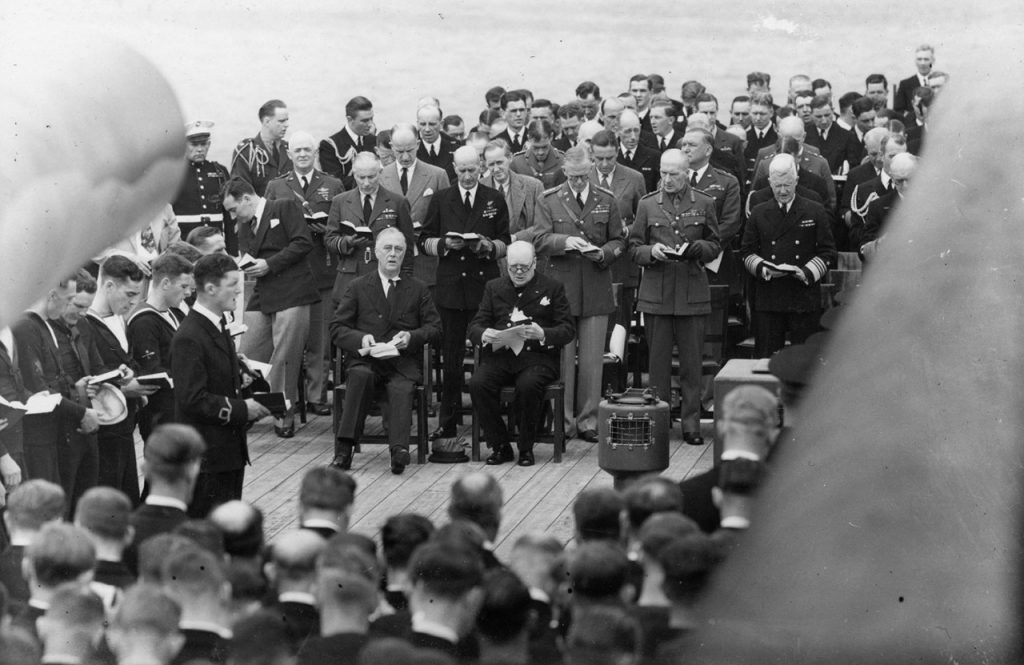FDR and Winston Churchill Issue Atlantic Charter | 10 August 1941
This photograph was taken during a secret diplomatic meeting between U.S. President Franklin D. Roosevelt and British Prime Minister Winston Churchill aboard the HMS Prince of Wales on August 10, 1941. FDR and Churchill were participating in a religious service, joined by their senior diplomats, top military advisors, and hundreds of servicemen, gathered to commemorate the signing of the Atlantic Charter. The extraordinary diplomatic moment was the first face-to-face meeting between the two leaders. Moreover, U.S. involvement in the Atlantic Charter, which was fundamentally a joint commitment to counter wartime aggression by the Axis powers, was part of FDR’s diplomatic strategy to support the British war effort without formalizing an alliance or entering the war. The signing of the Atlantic Charter is one of the key events in the “special relationship” between the United States and Great Britain that enshrined shared internationalist values during World War II and after. It is also a powerful example of how personal diplomacy between two leaders has shaped the history of American foreign relations.
President Franklin D. Roosevelt and Prime Minister Winston Churchill at a church service framed by gun turrets aboard the HMS Prince of Wales on August 10, 1941
Context
The prayer service aboard the Prince of Wales was described as an historic moment by those who experienced it. In a letter to King George VI on August 11, FDR wrote, “our talks are bearing practical fruit for both nations” and praised the gathering as a model of Anglo-American solidarity—a theme that would be crucial to the functioning of the the alliance between the U.S. and United Kingdom after the bombing of Pearl Harbor four months later. Having given special attention to planning the service, including choosing the hymns, Churchill would later describe the service as “a deeply moving expression of the unity of faith of our two peoples.” As Churchill lamented in his recounting, just four months later the Prince of Wales would be sunk by Japanese aircraft, killing nearly half the crew.
Significance
One of the most significant results of the meetings between FDR and Churchill was the Atlantic Charter declaration that the two men drafted. Although not a legally binding agreement, the statement affirmed a joint commitment to counter wartime aggression by the Axis powers. It also articulated a vision for a postwar world order by identifying eight principles that reflected a shared commitment to liberal, internationalist values. The principles included no territorial gains as a result of the war and a pledge that any territorial adjustments would be made in consultation with the peoples affected. Self-determination was a right to be afforded to all people. Lower trade barriers, freedom of the seas, and global economic cooperation were also listed. The two leaders committed to disarming aggressor nations, and, in ideological language that reflected FDR’s New Deal domestic policies, pledged to work toward freedom from fear and want for all people.
Because it was not legally binding, the Atlantic Charter was not easily translated into practice. Contemporary critics observed that the document in effect supported the colonialism of both the British Empire and the United States, despite language to the contrary. More a pragmatist than an idealist, Churchill had no intention of transforming the war-torn British Empire into an experiment of self-determination. Other critics understood Churchill’s motives and viewed the charter as a diplomatic maneuver to counter Soviet presence in Eastern Europe. FDR’s desire to produce the charter was based in part on his ideological convictions, but also on his certainty by August 1941 that the world war would spread to the United States. Like the Lend-Lease Act signed into law in March 1941, which allowed the U.S. to supply food, economic aid, and even war materials to enemies of the Axis powers including the Free French, the USSR, and the United Kingdom, the Atlantic Charter laid down a foundation for the U.S. joining the Allied Powers in December 1941.
At the end of the war, the Atlantic Charter exercised continued influence on the new global order. The document’s calls for democracy and political freedoms would set the basis for common principles that bound the two nations after the war. Moreover, the charter has been hailed as a blueprint for the United Nations. Indeed, the phrase United Nations was first used in a published declaration of January 1, 1942, after the U.S. entered the war, in which all of the Allied nations pledged themselves to support the principles of the Atlantic Charter. In their joint affirmation “of certain common principles in the national policies of their respective countries on which they based their hopes for a better future for the world,” FDR and Churchill articulated a postwar world order built on shared national and cultural values.
Resources
Elizabeth Borgwardt, “When You State a Moral Principle, You Are Stuck with It: The Atlantic Charter as a Human Rights Instrument.” Virginia Journal of International Law. Volume 46, No. 3 (2006): 501-562.
Douglas Brinkley, ed., The Atlantic Charter (The World of the Roosevelts) (Palgrave USA 1994)
Walter LaFeber, The Origins of the Cold War, 1941-1947: A Historical Problem with Interpretations and Documents (Problems in American History) John Wiley and Sons, 1971.
David F. Schmitz, The Triumph of Internationalism: Franklin D. Roosevelt and a World in Crisis, 1933-1941 (Issues in the History of American Foreign Relations) Potomac Books, 2007.
